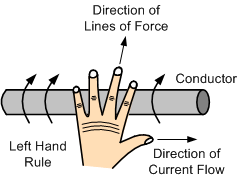in order to produce a much stronger and more controllable magnetic field we need to use electricity.
By using coils of wire wrapped or wound around a soft magnetic material such as an iron core we can produce very strong electromagnets for use in many different types of electrical applications.
This use of coils of wire produces a relationship between electricity and magnetism that gives us another form of magnetism called Electromagnetism.
Electromagnetism is produced when an electrical current flows through a simple conductor such as a length of wire or cable, and as current passes along the whole of the conductor then a magnetic field is created along the whole of the conductor.
The small magnetic field created around the conductor has a definite direction with both the “North” and “South” poles produced being determined by the direction of the electrical current flowing through the conductor.
Magnetic Field around a Conductor


A simple way to determine the direction of the magnetic field around the conductor is to consider screwing an ordinary wood screw into a sheet of paper. As the screw enters the paper the rotational action is CLOCKWISE and the only part of the screw that is visible above the paper is the screw head.
Another more familiar concept which determines both the direction of current flow and the resulting direction of the magnetic flux around the conductor is called the “Left Hand Rule”.

The recognised direction of a magnetic field is from its north pole to its south pole. This direction can be deduced by holding the current carrying conductor in your left hand with the thumb extended pointing in the direction of the electron flow from negative to positive.
Electromagnetism around a Loop


The current flowing through the two parallel conductors of the loop are in opposite directions as the current through the loop exits the left hand side and returns on the right hand side. This results in the magnetic field around each conductor inside the loop being in the “SAME” direction to each other.
The resulting lines of force generated by the current flowing through the loop oppose each other in the space between the two conductors where the two like poles meet thereby deforming the lines of force around each conductor as shown.
However, the distortion of the magnetic flux inbetween the two conductors results in an intensity of the magnetic field at the middle junction were the lines of force become closer together. The resulting interaction between the two like fields produces a mechanical force between the two conductors as they try to repel away from each other. In an electrical machine this repelling of these two magnetic fields produces motion.

The magnetic field generated around a straight length of current-carrying wire is very weak even with a high current passing through it. However, if several loops of the wire are wound together along the same axis producing a coil of wire, the resultant magnetic field will become even more concentrated and stronger than that of just a single loop. This produces an electromagnetic coil more commonly called a Solenoid.
'Electronics > Electromagnetics' 카테고리의 다른 글
| electromagnets (0) | 2022.05.01 |
|---|---|
| Chambers in Egypt’s Great Pyramid concentrate radio waves (0) | 2022.05.01 |
| Magnetism (0) | 2022.04.30 |
| 니콜라 테슬라 평전 (0) | 2022.04.28 |
| 전자기 시대를 연, 물리학의 두 거장 패러데이와 맥스웰 (0) | 2022.04.28 |


